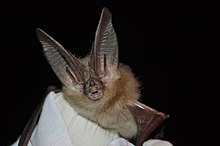Townsend's big-eared bat
| Townsend's big-eared bat | |
|---|---|
 |
|
| Scientific classification | |
| Kingdom: | Animalia |
| Phylum: | Chordata |
| Class: | Mammalia |
| Order: | Chiroptera |
| Family: | Vespertilionidae |
| Genus: | Corynorhinus |
| Species: | C. townsendii |
| Binomial name | |
|
Corynorhinus (Plecotus) townsendii Cooper, 1837 |
|
Townsend's big-eared bat (Corynorhinus townsendii) is a species of vesper bat.
Townsend's big-eared bat is a medium-sized bat (7-12 g) with extremely long, flexible ears, and small yet noticeable lumps on each side of the snout. Its total length is around 10 cm (4 in.), its tail being around 5 cm (2 in) Its wingspan is about 28 cm (11 in).
C. townsendii can be found in Canada, Mexico, and United States.
The mating season for the Townsend's big-eared bat takes place in late fall. As with many other bat species, the female stores sperm in her reproductive tract after mating, and fertilization occurs in the spring. Gestation lasts from 50 to 60 days. As with other bat species, pups are born without the ability to fly. Only one pup is birthed per female. One study found the average lifespan of a Townsend's big-eared bat to be 16 years. This bat requires large cavities for roosting; these may include abandoned buildings and mines, caves, and basal cavities of trees. During the summer, males and females occupy separate roosting sites; males are typically solitary, while females form maternity colonies, where they raise their pups. A maternity colony may range in size from 12 bats to 200, although in the eastern United States, colonies of 1,000 or more have been formed. During the winter, these bats hibernate, often when temperatures are around 32 to 53 °F (around 0 °C to 11.5 °C.) Hibernation occurs in tightly packed clusters, which could possibly help stabilize body temperatures against the cold. Males often hibernate in warmer places than females and are more easily aroused and active in winter than females. The bats are often interrupted from their sleep because they tend to wake up frequently and move around in the cave or move from one cave entirely to another. Before hibernation, C. townsendii individuals increase their body mass to compensate for the food they do not eat during the winter.
This species is a moth specialist, and may feed almost exclusively on Lepidoptera. However, this species' diet may include small moths, flies, lacewings, dung beetles, sawflies, and other small insects. This species is a whisper bat, which means that it echolocates at much lower intensities than other bats and may be difficult to record using a bat detector. This may be in part because this species specializes on moths, and some moths have the ability to hear bats and may produce their own noises to 'jam' a bat's echolocation in an effort to thwart predation.
...
Wikipedia

